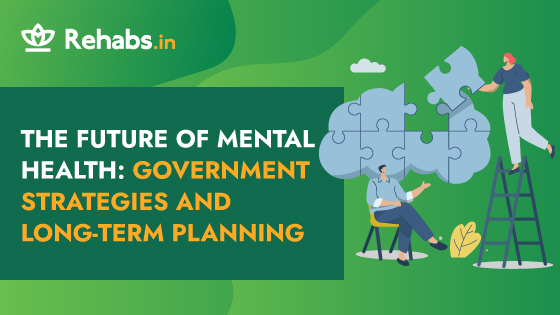The Future of Mental Health: Government Strategies and Long-Term Planning

The prevalence of mental health issues is a growing concern in India, emphasizing the critical need for government strategies to address this challenge. The burden of mental health disorders in India is substantial, with millions of people affected by conditions ranging from depression and anxiety to more severe disorders.
According to a study, approximately 150 million Indians are in need of active intervention for mental health issues. This alarming statistic underscores the urgency of implementing effective government strategies to address the growing crisis. This article aims to delve into the future of mental health in India, examining the government’s initiatives and long-term planning to combat mental health issues effectively.
The purpose of this article is to shed light on the current mental health landscape in India, government policies and programs, awareness and stigma reduction efforts, the long-term vision for mental health, collaborations and partnerships, as well as the challenges and innovative solutions in the field.
Current Mental Health Landscape
The current mental health landscape in India reveals a pressing need for comprehensive and accessible mental health services. According to a study, the treatment gap for mental health disorders in India is substantial, with the majority of affected individuals not receiving appropriate care. The challenges are exacerbated by the shortage of mental health professionals, limited infrastructure, and disparities in access to services, especially in rural areas.
Despite the growing awareness of mental health issues, India faces challenges, stigma, and significant gaps in mental health services. Stigmatization and discrimination associated with mental illness remain prevalent in society. The National Mental Health Survey of India (2016) found that stigma prevents individuals from seeking help, leading to delayed or inadequate treatment. Addressing these challenges is imperative to improve the overall mental health landscape.
It’s encouraging to see a surge in awareness around mental health issues, as more individuals and communities recognize the importance of addressing these concerns. The efforts of organizations like the Live Love Laugh Foundation, led by Deepika Padukone, have played a pivotal role in raising awareness and reducing stigma. The organization focuses on spreading awareness, advocating for mental health, and providing support to those in need. This is indicative of a positive shift in the public perception of mental health issues.
Government Initiatives and Policies
The Indian government has introduced a range of initiatives and policies aimed at improving mental health outcomes in the country. The Mental Healthcare Act, 2017 stands as a significant milestone in this regard, emphasizing the rights of individuals with mental illnesses and mandating access to mental healthcare services. This act is a reflection of the government’s commitment to providing better mental health services and reducing stigma.
One such program, the National Mental Health Program (NMHP), has specific objectives geared toward addressing mental health challenges at the national level. Established in 1982, the NMHP aims to provide accessible, affordable, and quality mental health care through a district mental health program. It focuses on the prevention and treatment of mental disorders and the promotion of mental health.
Additionally, the government has forged partnerships with non-governmental organizations and initiated state-level programs to enhance mental health services. The Rashtriya Bal Swasthya Karyakram (RBSK), for instance, integrates mental health services into the healthcare system for children. Such collaborative efforts between government agencies and NGOs are pivotal in extending the reach of mental health services.
Awareness and Stigma Reduction
Government-led efforts to raise awareness and reduce stigma related to mental health issues are becoming increasingly visible in India. The “Stamp Out Stigma” campaign, by the Schizophrenia Research Foundation (SCARF), has made significant strides in combatting stigma. This community-level campaign focused on reducing mental health stigma, encouraging individuals to seek help, and facilitating early interventions.
Public campaigns and educational programs play a pivotal role in informing the population about mental health concerns and potential solutions. Organizations like “VSO India” have implemented various mental health programs to increase awareness and provide support. These programs often involve community outreach, training sessions, and the distribution of informational materials.
While there have been success stories in reducing stigma, challenges persist on the path to a stigma-free society. Achieving meaningful and lasting changes in societal perceptions necessitates continued efforts by the government and non-profit organizations. It also underscores the importance of collaborations and partnerships in addressing these challenges.
Long-Term Planning and Vision
India envisions a long-term approach to mental health, ensuring a healthier future for its citizens. The government’s National Mental Health Policy is a testament to this vision. This policy emphasizes the integration of mental health services into primary healthcare and the involvement of a range of stakeholders. It lays out the roadmap for addressing mental health issues in the long term.
This vision emphasizes the role of research, data collection, and mental health advocacy in shaping future policies and initiatives. Organizations like the Public Health Foundation of India (PHFI) are at the forefront of conducting research on mental health in India. They gather critical data and insights that contribute to the formulation of evidence-based policies.
Sustainable funding and resource allocation are paramount in achieving the long-term goals for mental health in India. The government’s commitment to allocating resources for mental health services is evident in the increasing budgetary allocation for mental health programs over the years.
Collaboration and Partnerships
Collaboration between government agencies, non-profits, and international organizations reflects a multi-sectoral approach to addressing mental health concerns. The World Health Organization (WHO) plays a pivotal role in guiding global mental health policies. India’s collaborations with such organizations ensure that its mental health initiatives align with international standards.
The significance of such collaborations cannot be overstated, as they bring together diverse resources and expertise to tackle mental health challenges. India’s association with non-profit organizations like Sangath and Basic Needs emphasizes the importance of community-based approaches and inclusive mental health strategies.
Case studies showcasing successful partnerships highlight the potential for collective action to make a significant impact on mental health outcomes. Collaborative projects like the “It’s Ok To Talk” initiative, in association with Youth Ki Awaaz, have reached thousands of individuals with messages of hope and support.
Challenges and Solutions
Addressing the challenges and obstacles within the mental health system is essential for improving mental health outcomes in India. Challenges include the shortage of mental health professionals, particularly in rural areas, and the need for better infrastructure.
Telemedicine and online counselling services have emerged as viable solutions to bridge the gap in access to mental health services. These technologies facilitate remote consultations and support.
The role of community involvement and mental health advocates in surmounting obstacles in the mental health landscape cannot be underestimated. Organizations like iCall are actively involving community members to provide mental health support. Initiatives like these are invaluable in reaching individuals who may otherwise remain underserved.
Sources:
- Basic Needs. (n.d.). [Website of Basic Needs]. Retrieved from https://www.basicneeds.org/
- Government of India. (2013). Rashtriya Bal Swasthya Karyakram (RBSK). https://www.nhp.gov.in/rbsk_pg
- Government of India. (2014). National Mental Health Policy of India. https://mohfw.gov.in/sites/default/files/8488456877.pdf
- Government of India. (2016). National Mental Health Program. https://mohfw.gov.in/Mental%20Health
- Government of India. (2017). The Mental Healthcare Act, 2017. http://egazette.nic.in/WriteReadData/2017/175248.pdf
- Gururaj, G., Varghese, M., Benegal, V., Rao, G. N., Pathak, K., Singh, L. K., … & National Mental Health Survey of India, 2016. (2016). National Mental Health Survey of India, 2015-16: Prevalence, patterns and outcomes. Bengaluru, National Institute of Mental Health and Neuro Sciences, NIMHANS Publication No. 129.
- iCall. (n.d.). [Website of iCall]. Retrieved from https://www.icallhelpline.org/
- Live Love Laugh Foundation. (2021). https://www.thelivelovelaughfoundation.org/
- Manjunatha, N., Kumar, C. N., Math, S. B., Thirthalli, J., & Chaturvedi, S. K. (2020). Teleconsultation and telesupport to manage severe mental illness in times of crisis: The COVID-19 experience from India. International Journal of Social Psychiatry, 66(6), 625-627.
- Patel, V., Chisholm, D., Parikh, R., Charlson, F. J., Degenhardt, L., Dua, T., … & Whiteford, H. (2015). Global priorities for addressing the burden of mental, neurological, and substance use disorders. In Mental, Neurological, and Substance Use Disorders: Disease Control Priorities, Third Edition (Volume 4). The International Bank for Reconstruction and Development/The World Bank.
- Sangath. (2022). [Website of Sangath]. Retrieved from http://www.sangath.in/
- Singh, A., Mattoo, S. K., Grover, S., & Chakrabarti, S. (2018). Stigma and its correlates among patients with bipolar disorder: A study from a tertiary care hospital of North India. Journal of Neurosciences in Rural Practice, 9(1), 102-108.
- Subramaniam, M., Abdin, E., Vaingankar, J. A., & Phua, A. (2017). Tracking the impact of a national anti-stigma campaign on a community level: The case of “Stamp Out Stigma.” Psychiatry Research, 255, 49-54.
- VSO India. (n.d.). [Website of VSO India]. Retrieved from https://www.vsoindia.org/
- WHO. (2019). Mental health. Retrieved from https://www.who.int/news-room/fact-sheets/detail/mental-disorders
- Youth Ki Awaaz. (2021). It’s Ok To Talk: Making Mental Health Accessible in India. Retrieved from https://www.youthkiawaaz.com/2021/10/its-ok-to-talk-making-mental-health-accessible-in-india/














